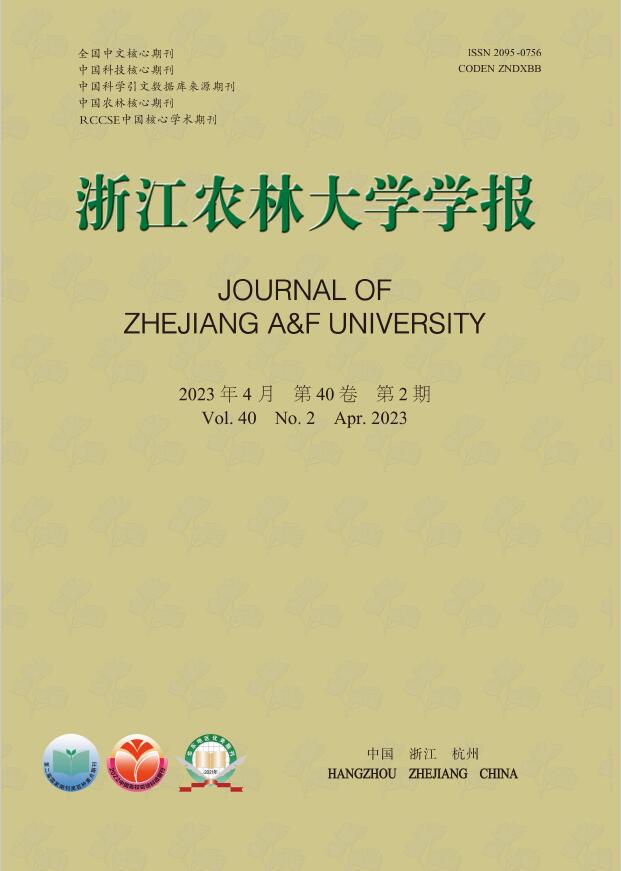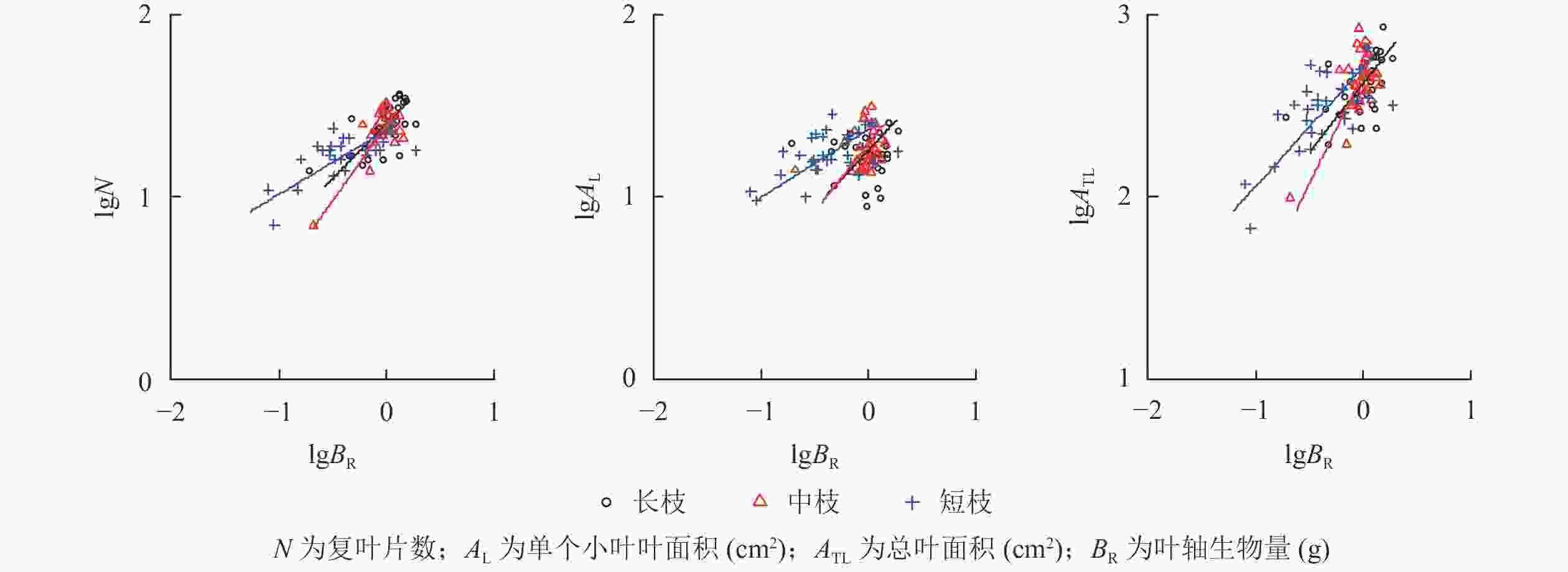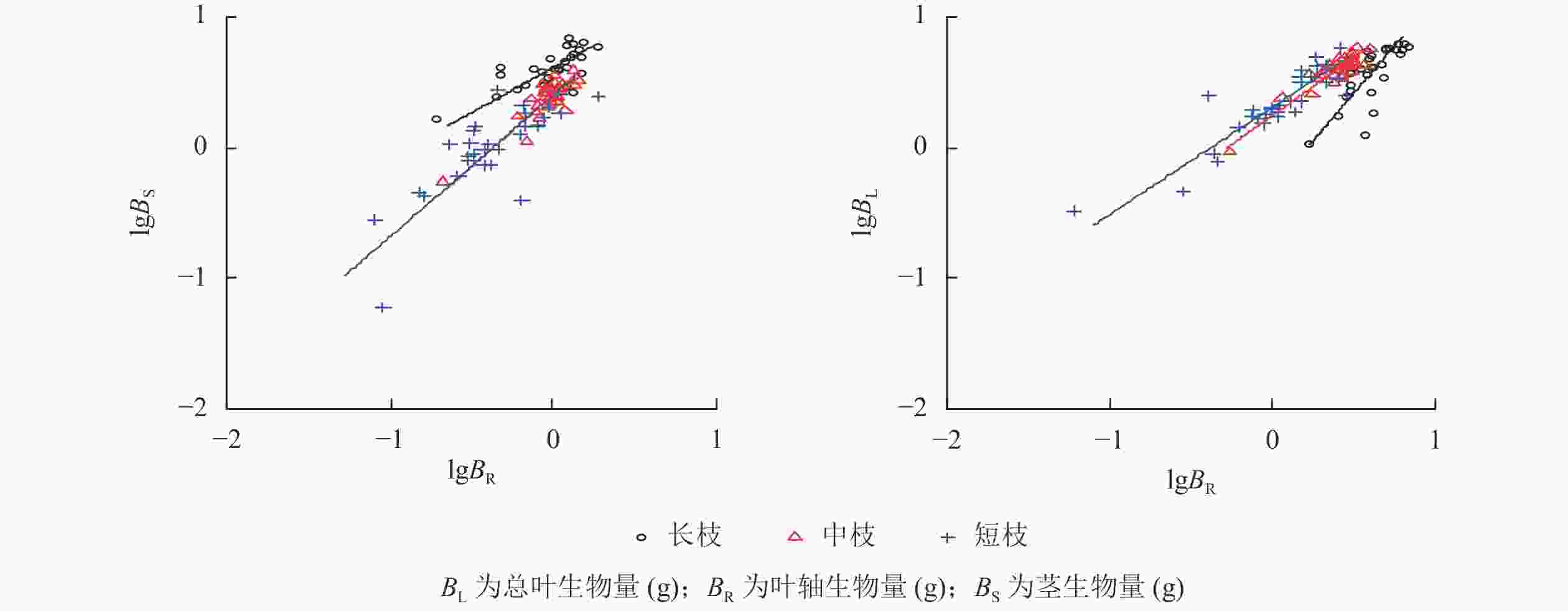-
当年生枝条是木本植物进行种群空间扩展、结实和光合作用的主要部位,与种群的生长、繁殖、存活等密切相关。探讨当年生枝条的茎、叶构件之间的异速生长规律是揭示植物种群适应机制的有效途径之一[1−3]。迄今有关这方面的研究已经有很多积累,主要是通过对茎和叶回归方程斜率的显著性检验和大小的比较,开展当年生枝条茎和叶异速生长规律随环境梯度[4−6]、种间亲缘关系[7−10]或植物生活型[11−12]变化的对比研究,以验证茎对叶片光合生产的支持能力[13−17]和构件生物量的分配规律[18−19]。此类研究大多在种间水平上比较茎、叶的生长关系,进而分析其生态、生理的联系性,隐含的前提是物种的差异性和特殊性可以忽略。
对于温带落叶木本植物,难以忽略的是枝条功能的种内分化现象[20],或者称为枝条的二态性。不同类型枝条(长枝、短枝)的叶型[21]、生理生化特征[22−25]、生长特性等都可能存在差异,由此必然引起枝条不同构件间的异速生长关系发生变化,因此,不同类型枝条的茎、叶生长规律的异同,携带着进化和适应调节等重要信息。根据以往的认识,长枝功能侧重种群生长空间扩展,短枝功能侧重光合生产[26−27],具体到构件生长层面则是长枝侧重茎的生长,短枝侧重叶片的生长。但是,木本植物枝条功能分化与光照条件[28−29]以及有性繁殖过程有关,长枝、短枝的生长特征及其在种群调节中的作用可能存在环境差异性或者物种特异性,针对不同的植物种群仍需验证。
小叶白蜡Fraxinus sogdiana又名天山梣,是木樨科Oleaceae梣属Fraxinus落叶乔木,为第三纪温带阔叶林残遗树种,被2021年《国家重点保护野生植物名录》列为Ⅱ级,具有重要的科学价值和园林应用价值,目前仅在伊犁河谷喀什河河岸带尚有大面积集中分布。小叶白蜡枝条生长的独特性在于同一分枝上长枝、短枝等不同类型枝条交替发育,并且长枝和短枝都可能发育为生殖枝,呈现非常明显的枝条分化以及生长调节特征。张维等[30]和努尔买买提等[31]对小叶白蜡复叶生物量分配和表型可塑性方面进行过研究。但对小叶白蜡枝条如何发生分化、不同类型枝条的生长特征及其功能、构件生物量分配权衡等问题了解甚少。本研究分析小叶白蜡3种不同类型枝条(长枝、中枝和短枝)各构件之间的异速生长关系,通过比较异速生长方程的斜率了解不同类型枝条功能的差异性,以期为小叶白蜡种群生长调节、适应与进化等研究提供科学依据。
-
研究地点位于新疆维吾尔自治区伊犁哈萨克自治州小叶白蜡国家级自然保护区(43°42′08″~43°50′47″N,81°49′42″~82°10′37″E),该区属典型的大陆性半干旱气候,年均气温为8.5 ℃,年均降水量为330 mm,年均蒸发量为1 300~1 700 mm。保护区内地貌主要为第四纪冲积物形成的河漫滩、阶地等堆积地貌,上覆深厚的黄土层。土壤类型以灰钙土和栗钙土为主[30−31]。保护区的保护对象为原始小叶白蜡林,属河谷落叶阔叶林,乔木主要伴生密叶杨Populus talassica、天山桦Betula tianschanica等,下层草本植物以温带分布种类为主[30−31]。
-
2019年10月中旬,在保护区内小叶白蜡分布的集中地段布置样地,样地面积为50 m×50 m。取样地段的地貌为河岸带一级阶地,地势平坦,株间距约5~6 m,林木分布较为均匀。在样地内选择长势良好、均一的10株小叶白蜡成株作为目标树,胸径为(42.93±18.46) cm,树高为(12.40±1.14) m,为保证林木年龄的一致性,去除系统发育差异的影响。按不同方向在树冠外层的中、下部位随机采摘完整、健康的不同类型当年生枝条各5条,最终每个类型枝条各获得50个样品,保留其中30个相对好的枝条作为研究对象。由于小叶白蜡当年生枝条长枝和短枝既可能发生在主枝上,也可能发生在侧枝上,通过枝位无法判断枝条类型,因此,本研究通过最大叶间距判断枝条类型。小叶白蜡羽状复叶在枝条上呈螺旋状三叶轮生,具有清晰可辩的节状叶痕,可获得较准确的叶间距数据,标准如下:最大叶间距>2 cm判断为长枝,1~2 cm判断为中枝,<1 cm判断为短枝。带回室内后测量复叶片数和小叶叶面积,叶面积使用叶面积仪(LI3000C,LI-Cor,美国)测量。测定后将枝条按照叶轴、茎、叶片分开,85 ℃烘干至恒量,用0.01%电子天平称量获得生物量数据。
-
异速生长采用幂函数方程描述,并对自变量和因变量进行对数转换,获得线性方程lgy=lgb+algx,方程参数采用标准主轴回归(SMA)方法[32]进行估计,其中y为因变量,x为自变量,a为方程斜率,b为截距。本研究重点关注斜率的变化,若斜率a显著大于或小于1,则为异速生长关系,否则为同速生长关系。同时,也在3种类型枝条之间两两比较斜率差异显著性,若差异不显著,则认为斜率相同。
所有统计分析应用R语言完成,异速生长分析应用R语言smatr程序包[33]完成。所有统计分析显著水平为0.05。
-
由表1和图1所示:3种类型枝条的茎生物量与总叶面积均存在显著相关性(P<0.05),长枝和中枝均为同速生长关系,斜率分别为1.170和1.135,经检验无显著差异(P>0.05),而在短枝上为异速生长关系,斜率为0.657,显著小于长枝和中枝(P<0.05)。但是,长枝和中枝与单个小叶面积无相关性(P>0.05),与复叶片数存在异速生长关系(P<0.05),而短枝则与单个小叶面积和复叶片数均存在显著的异速生长关系(P<0.05)。
茎与叶片 变量 斜率 截距 R2 回归方程
P值异速生长
检验P值复叶片数-
茎生物量长枝 0.879 a 0.858 0.617 0.000 0.014 中枝 0.750 a 1.083 0.661 0.000 0.013 短枝 0.330 b 1.236 0.708 0.000 0.000 单个小叶面
积-茎生物量长枝 0.836 a 0.411 0.003 0.771 − 中枝 0.735 a 0.688 0.077 0.138 − 短枝 0.397 b 0.938 0.326 0.001 0.000 总叶面积-
茎生物量长枝 1.170 a 1.601 0.398 0.000 0.922 中枝 1.135 a 1.903 0.513 0.000 0.343 短枝 0.657 b 2.174 0.591 0.000 0.001 说明:斜率后不同字母表示同一指标在不同类型枝条间差异显著(P<0.05)。–表示回归方程不显著,不进行异速生长检验 Table 1. Parameters and significance test of stem-leaf regression equations of F. sogdiana shoot
-
表2和图2所示:3种类型枝条总叶面积与叶轴生物量均存在显著相关性(P<0.05),其中长枝和中枝为同速生长关系(P>0.05),而短枝为异速生长关系(P<0.05)。但是,长枝和中枝的叶轴生物量与单个小叶面积并不存在相关性,而与复叶片数存在异速生长关系(P<0.05),表明长枝和中枝叶轴主要通过复叶片数增加总叶面积。短枝的叶轴与复叶片数和单个小叶面积均存在异速生长关系(P<0.05),表明短枝叶轴主要通过单个小叶面积和复叶片数增加总叶面积。
叶轴与叶片 变量 斜率 截距 R2 回归方
程P值异速生长
检验P值复叶片数-
叶轴生物量长枝 0.601 a 1.403 0.436 0.000 0.000 中枝 0.829 a 1.395 0.389 0.000 0.002 短枝 0.353 b 1.368 0.468 0.000 0.000 单个小叶面积-
叶轴生物量长枝 0.571 ab 0.929 0.024 0.423 − 中枝 0.812 a 0.994 0.002 0.154 − 短枝 0.424 b 1.097 0.273 0.003 0.000 总叶面积-
叶轴生物量长枝 0.800 b 2.326 0.368 0.000 0.107 中枝 1.255 a 2.376 0.431 0.000 0.119 短枝 0.701 b 2.437 0.436 0.000 0.016 说明:斜率后不同字母表示同一指标在不同类型枝条间差异显著(P<0.05)。−表示回归方程不显著,不进行异速生长检验 Table 2. Parameters and significance test of rachis-leaf regression equations of F. sogdiana shoot
另外,在3种类型枝条之间叶的各项指标与叶轴生物量的斜率均以中枝最高,尤其总叶面积和叶轴的斜率达1.255,显著高于长枝和短枝(P<0.05),显示出最大的叶面积支持效率。
-
从表3可见:3种类型枝条的茎生物量和叶轴生物量之间均具有显著的相关性(P<0.05),其中,在长枝上表现为异速生长关系(P<0.05),斜率为0.683,在中枝和短枝上表现为同速生长关系(P>0.05),斜率分别为1.105和1.067,且均显著高于长枝(P<0.05)。
生物量分配 变量 斜率 截距 R2 回归方程
P值异速生长
检验P值茎生物量-
叶轴生物量长枝 0.683 b 0.620 0.508 0.000 0.007 中枝 1.105 a 0.417 0.748 0.000 0.299 短枝 1.067 a 0.400 0.643 0.000 0.570 叶总生物量-
茎生物量长枝 1.459 a −0.303 0.512 0.000 0.008 中枝 0.908 b 0.243 0.817 0.000 0.242 短枝 0.840 b 0.327 0.799 0.000 0.048 说明:斜率后不同字母表示同一指标在不同类型枝条间差异显著(P<0.05) Table 3. Parameters and significance test of regression equations for biomass allocation of F. sogdiana shoot
在伊犁河谷小叶白蜡当年生枝条的生物量分配关系(图3)中发现:叶片总生物量和茎生物量之间的关系在不同类型枝条上不同。其中,在长枝上斜率为1.459,显著大于1 (P<0.05),表现为异速生长关系;在中枝上斜率为0.908 (P>0.05),表现为同速生长关系;在短枝上斜率为0.840,显著小于1 (P<0.05),表现为异速生长关系。
-
植物种群在进化适应过程中总是要不断的调节构件生长,当年生枝条作为木本植物最为活跃的构件,茎和叶生长模式是其最重要的调节方式之一。但是在不同环境或不同生活型之间,茎和叶生长模式差异较大,并不存在一致性。以往在种间水平报道的茎和叶片生长关系既有异速模式[34−35],也有同速模式[36−37],这可能与不同的物种对环境梯度的进化反映差异有关。本研究在种内构件的水平上分析了不同类型枝条的生长特征,结果发现茎和叶的异速生长关系与枝条的类型有关。其中,在长枝和中枝上,茎生物量与总叶面积为同速生长关系,在短枝上,茎生物量与总叶面积为异速生长关系。因此,在解释生态过程时,有必要从不同的组织尺度上开展相关研究。
不同构件之间回归方程的斜率已经被广泛用来解释植物生长的权衡。本研究中,总叶面积与茎生物量的斜率在长枝和中枝上分别为1.170和1.135,在短枝上为0.657。说明随着茎生物量增加,长枝和中枝具有更高的叶面积支持效率(单位长度枝条的叶面积),并且主要与叶片数的增加有关,而与单个小叶叶面积无关,反之,短枝的总叶面积支持效率较低。这一规律在生物量分配中体现的尤为明显,长枝、中枝和短枝的叶片和茎生物量异速生长方程的斜率依次为1.459、0.908和0.840,叶片生物量分配比例依次降低。
综上,长枝的功能不仅体现在扩展种群生长空间上,同样体现在光合生产功能上,而短枝的功能在这2个方面相对较弱,这一点与以往的研究不同[26−27]。另外,曾凡江等[25]对新疆杨Populus alba var. pyramidalis长枝和短枝的叶水分生理特性研究表明:长枝叶片具有更高的蒸腾速率,光合速率与蒸腾速率往往存在显著的正相关关系,这与本研究小叶白蜡长枝具有较强光合功能的观点一致。
-
对于木本复叶植物,叶轴与茎共同构成枝条的支持系统,叶轴对于叶片生长也具有重要的调节作用,如努尔买买提等[31]研究表明:小叶白蜡的复叶长与叶轴长之间为异速生长关系,本研究的总叶面积和叶轴生物量之间同样存在异速生长关系。另外,将总叶面积和茎生物量的斜率与总叶面积和叶轴生物量的斜率进行对比发现:在长枝上前者为1.170,后者为0.800,表现出变小的趋势,而在中枝和短枝上,前者分别为1.135和0.657,后者分别为1.255和0.701,均表现出变大的趋势。表明长枝上茎具有更高的叶面积支持效率,而中枝和短枝上叶轴具有更高的叶面积支持效率。进一步说明叶轴对于中枝和短枝具有更为重要的作用,可以弥补茎对叶面积支持效率的不足,体现出叶轴的生态适应意义。
综上,在支撑结构上,长枝侧重于茎的生长,而叶轴的生长不足,从投资-收益权衡的角度可以理解为避免浪费过多的资源用于支持系统,而中枝和短枝则为茎和叶轴的生长并重,或者说需要增加叶轴的生长来弥补茎的生长不足,以提高对叶片的支持效率。
-
在长期进化适应过程中,小叶白蜡分化出复杂的枝条系统,长枝具有更长的茎和更多的叶片,似乎短枝无论在提高光合功能,还是拓展种群生长空间上,都不存在任何优势。而且,根据野外现场调查,在同一个一级分枝上,短枝与长枝的数量比例平均为15.1∶1.0,变异范围介于37.5∶1.0~1.5∶1.0,且分枝直径越大,短枝越多。由此产生的问题是短枝不存在任何生长优势,为什么还大量存在,对于这个问题需要结合小叶白蜡的结实生物学特征来理解。小叶白蜡当年生枝条不结实,而是2年生的枝条结实。据野外对结实植株的调查显示:如果当年生枝条为短枝,则去年生枝条结实量为12.15~12.94 g (鲜质量),当年生枝条叶片质量10.42~12.73 g (鲜质量);如果当年生枝条为长枝,则去年生枝条结实量为5.89~6.22 g (鲜质量),当年生枝条叶片质量16.28~25.92 g (鲜质量)。可见,小叶白蜡的枝条大小与结实之间存在权衡关系,短枝的大量发育是有性繁殖权衡的结果,这也符合植物种群生长和繁殖权衡的一般性规律。
-
小叶白蜡的长枝和中枝具有更高的叶片支持效率,其功能不仅体现在扩展种群生长空间方面,同样也体现在较高的光合生产能力方面,短枝的叶片支持效率较低,其功能与种群的有性繁殖过程密切相关。叶轴对叶片生长也有调节作用,在中枝和短枝上能够弥补茎对叶面积支持效率的不足,但在长枝上作用不明显。总之,小叶白蜡当年生枝条具有更为复杂的枝条功能分化,种群适应调节方式也更加多样化,研究具有二态性枝条的植物生长调节特征时需要考虑枝条类型的差异性。
Growth regulation characteristics of current-year shoots of Fraxinus sogdiana in Yili River Valley
doi: 10.11833/j.issn.2095-0756.20220243
- Received Date: 2022-03-23
- Accepted Date: 2022-10-12
- Rev Recd Date: 2022-09-25
- Available Online: 2023-04-03
- Publish Date: 2023-04-20
-
Key words:
- Fraxinus sogdiana /
- biomass allocation /
- population regulation /
- allometric growth /
- modular /
- Yili River Valley
Abstract:
| Citation: | LI Dongyu, YU Yu, XU Shun, et al. Growth regulation characteristics of current-year shoots of Fraxinus sogdiana in Yili River Valley[J]. Journal of Zhejiang A&F University, 2023, 40(2): 382-389. DOI: 10.11833/j.issn.2095-0756.20220243 |













 DownLoad:
DownLoad:

